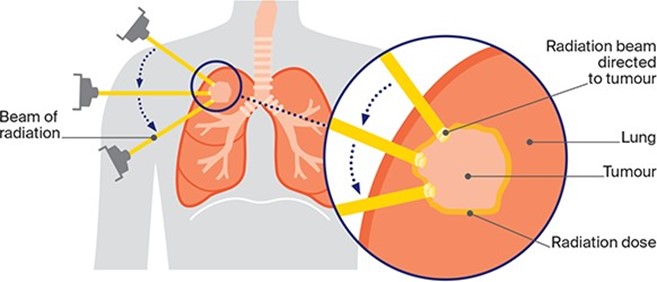A nurse is caring for a client who is receiving radiation therapy to treat lung cancer. Which of the following actions should the nurse take?
Observe for signs of infection
Examine the skin for generalized urticaria
Review laboratory test results for low hemoglobin
Monitor the mouth for signs of xerostomia
The Correct Answer is A
Radiation therapy can cause immunosuppression, which increases the risk of infection. The nurse should monitor the client for signs of infection such as fever, chills, malaise, or purulent drainage.
- Examine the skin for generalized urticaria. This is not a common side effect of radiation therapy, as urticaria is an allergic reaction that causes hives or welts on the skin. Radiation therapy can cause localized skin irritation, erythema, or dryness, but not generalized urticaria.
- Review laboratory test results for low hemoglobin. This is not a direct effect of radiation therapy, as hemoglobin is a component of red blood cells that carries oxygen in the blood. Radiation therapy can cause anemia, which is a low number of red blood cells, but not necessarily low hemoglobin.
- Monitor the mouth for signs of xerostomia. This is not relevant for a client who receives radiation therapy to treat lung cancer, as xerostomia is dry mouth caused by reduced salivary gland function. This can occur in clients who receive radiation therapy to treat head and neck cancer, but not lung cancer.

Nursing Test Bank
Naxlex Comprehensive Predictor Exams
Related Questions
Correct Answer is ["A","C","E"]
Explanation
These clients have impaired swallowing, gag reflex, or level of consciousness, which increase their risk of aspiration while eating.
The other options are not correct because:
b. A client who has had prolonged diarrhea does not have a direct risk factor for aspiration, as diarrhea affects the lower gastrointestinal tract and not the upper airway or esophagus.
d. A client who has lactose intolerance does not have a risk factor for aspiration, as lactose intolerance causes abdominal cramps, bloating, gas, or diarrhea when consuming dairy products, but does not affect the ability to swallow or protect the airway.
Correct Answer is ["A","D"]
Explanation
These responses are correct and explain how albuterol helps the client's breathing. Albuterol is a short- acting beta2-agonist that causes bronchodilation and relieves bronchospasm, which are the main causes of wheezing and dyspnea in clients who have asthma or COPD. By opening the airways, albuterol improves gas exchange and oxygenation.
b) The medication will decrease coughing episodes. This response is incorrect and does not explain how albuterol helps the client's breathing. Albuterol does not have a direct effect on coughing, which is a reflex response to irritation or obstruction of the airways. Coughing may be beneficial for clearing secretions and mucus from the lungs, but it may also cause bronchoconstriction and inflammation. The nurse should advise the client to use other measures to decrease coughing, such as drinking fluids, using a humidifier, or taking an expectorant.
c) The medication will reduce inflammation. This response is incorrect and does not explain how albuterol helps the client's breathing. Albuterol does not have an anti-inflammatory effect on the airways, which are often inflamed and swollen in clients who have asthma or COPD. Inflammation can contribute to airway obstruction and mucus production, which impair gas exchange and oxygenation. The nurse should inform the client that albuterol is used for quick relief of acute symptoms, but not for long-term control or prevention of inflammation. The client may need to use another medication, such as an inhaled corticosteroid, to reduce inflammation.
e) The medication will stimulate flow of mucus. This response is incorrect and does not explain how albuterol helps the client's breathing. Albuterol does not have a direct effect on mucus production or clearance, which are often increased in clients who have asthma or COPD. Mucus can cause airway obstruction and infection, which impair gas exchange and oxygenation. The nurse should advise the client to use other measures to stimulate flow of mucus, such as drinking fluids, using a humidifier, or taking an expectorant.

Whether you are a student looking to ace your exams or a practicing nurse seeking to enhance your expertise , our nursing education contents will empower you with the confidence and competence to make a difference in the lives of patients and become a respected leader in the healthcare field.
Visit Naxlex, invest in your future and unlock endless possibilities with our unparalleled nursing education contents today
Report Wrong Answer on the Current Question
Do you disagree with the answer? If yes, what is your expected answer? Explain.
Kindly be descriptive with the issue you are facing.
